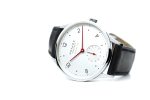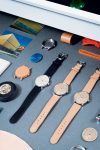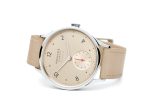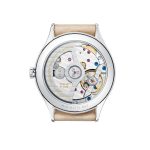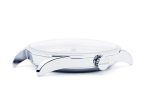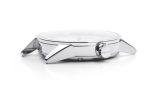NOMOS Glashütte
…Then We Take Berlin
As the reputation of Nomos continues to grow internationally, the company is increasingly heralded as a beacon of German watchmaking excellence. In equal measure, advocates praise the brand for its innovative movements that can only exist thanks to its manufacture in German watchmaking’s heartland, Glashütte, as well as its minimalist case and dial designs that are a product of its Berlin-based creative hub. Often categorised in the media as “Bauhaus”, Nomos prefers to say that its design principles are an extension of the “Deutscher Werkbund”, an early 20th-century movement that aimed to combine artisanal crafts and mass production, thus establishing the principles that allowed the Bauhaus school to come into existence. Closely linked to the English Arts and Crafts movement and the work of William Morris, defining Nomos within the boundaries of Deutscher Werkbund immediately gives both the design and purpose a more international flavour.
As an external product designer, Simon Husslein works on projects ranging from furniture to installations and spatial designs. Initially a student at Darmstadt University of Applied Sciences, Husslein went on to work at Studio Hannes Wettstein before enrolling on an MA course in Design Products at London’s Royal College of Art. “The course was run by Ron Arad, who was amazing and had a huge influence on me, as did many of the tutors,” recalls Husslein. But the main inspiration came from other students and the impact of being squeezed into this crazy building next to Kensington Gardens with 1,000 really talented people from all fields. There was an insane density of brilliance – I get goose bumps thinking about it. Following my two years in London, I could say with clarity what I liked and didn’t like. I could make a decision, hold opinions.
“I learned an understanding of personal freedom and decision-making and that it’s OK to think in a different way. And working for companies that produce in large numbers is not completely different. You might have to take more time to think if something is easy to produce or rational in its assembly. But if you can improve in design, you can eliminate a lot of unnecessary work and monetary waste.”
THE CASE IN QUESTION
In the style of Gérald Genta, Husslein is very much a designer- for-hire, and on the often-maligned merits of bringing external product designers into the watchmaking fold, he is thoughtful. “There are necessarily two sides to producing a modern watch,” he says. “I have huge respect for watches that have evolved from the engineering and history side, but today marketing is the driving force in many companies, so engineers being paramount is not always the case.
“It is important for external designers to bring new ideas but, at the same time, there is no point being different for the sake of it; the main thing is to try and make an object better or more sophisticated. For me, the aim should be to investigate what’s already been done and why, to look at how it is produced and what factors make it look that way. I then ask the question: ‘How can I work with that knowledge and change it?’ It is only with this kind of evolution that we can take a step up.”
Although Husslein admits that the Berlin-based design is an important element at Nomos, he points to the Glashütte manufacture and its in-house capabilities as evidence of how seriously the brand takes watchmaking development. Not least among the brand’s technical achievements is the “Swing System” introduced in 2014 – a true in-house escapement (including the escape wheel and pallets) and a feat that few manufacturers have the know-how to complete.
“It is important to keep the manufacture in Glashütte,” says Husslein, talking about design and watchmaking being split between two centres. “The relationship between countryside and mechanical work is an historical one. But equally it is necessary for creative minds to be closer to urban environments. It makes sense in terms of human resources and getting interesting people to contribute.
“The process is pretty simple for us. The movement comes first and we create around it. We make a story around each watch and reference a person we have in mind that would wear it. Starting from this point, I work on a case – but the movement always dictates design. You can’t just make a crazy beautiful case and ask: ‘How can we squeeze in the mechanics?’”
AROUND THE HOUSING
The first case design Husslein worked on for Nomos was the Zürich – although, as this was before he flew solo with Atelier Simon Husslein, it is still credited as a Studio Hannes Wettstein design. Concentrating on the tiniest details, the lugs were a major part of the design, with Husslein aiming to create an all-new shape with a unique re flection. And from his first watch to his most recent, Husslein says that this year’s Minimatik is another evolution for Nomos case design as it brings in new elements, such as integrated lugs creating a less rational shape than in the past.
“I wanted to explore how far Nomos could go and still retain its identity,” he says. “On all the other models the lug is added to the case. For Minimatik I decided on integrated lugs and a tapered case rather than a cylindrical one with the lugs running from the bottom of the case and then making a turn into a straight surface so it was parallel to the bezel. It was really a move from straight through turn and back to straight. What is nice about this angle is that from the top it almost floats as you see less of the case sides.”
The second design leap was to have a turn on the top of the lug making it more feminine and curvy. A nightmare for the engineers, this “pinch” in the lug was at first impossible to polish until Husslein found a solution whereby the bezel was added into the lug. “I proposed a solution to make the case three parts instead of two. Because of this the bezel can be removed, polished and reassembled. Although other Nomos watches have three-part cases, this was really a step up in complexity of design and development.”
Although not responsible for dial design per se, Husslein and his team always make suggestions for overall appearance. For the Minimatik, this involved collaborating with Nomos in-house designer Thomas Höhnel, a graduate of Berlin’s University of the Arts and Central Saint Martins College of Art and Design in London. As well as designing the quirky Nomos sports watch Ahoi, Höhnel also works on the brands straps, buckles, tools and packaging.
Where the Minimatik was concerned, Höhnel’s overall concept was to make something that stood out from the existing watch families. “We wanted a new, modern watch but it had to retain the same classic qualities as the other watches. We wanted to keep the curvy elements from the case so we decided to use dot indices instead of lines to give more dial space. The main character of the case is the straight lines and smooth shape so we chose very slightly tapered hands. The changes are subtle, but the watch is very different from the core collection.” When it comes to what makes a Nomos so very definitely a Nomos, Husslein and Höhnel are united. “The designers who have worked there for a long time understand the heart of the brand. It’s a feeling you can’t put into words. There are no written rules – most cases are three- part but some are two, there is usually a central seconds hand but sometimes there isn’t one – but it doesn’t matter, you can still spot a Nomos watch. Things must have their own voice, but must still relate to the existing product range.”
Sitting with two such accomplished product designers, I feel I have to ask who they currently rate in terms of watch design. After a long silence Höhnel sighs and says: “If you look at the watch market and the tradition of watchmaking, there is very little that hasn’t been done. When I see something radical, it intrigues me. I am fascinated by the work of Benoît Mintiens at Ressence – not so much for the final look of the watch but more out of respect for his radical approach of designing from the inner core out. It is always the tiny details that stick with me – a 3D effect or a particular crown guard.”
Husslein agrees: “I might find detail in a brand I’ve never heard of or never rated. I look for something in a lug, dial, bezel or appliqué, something that may be interesting up close. I love to look at the archetype of cool, lasting design from brands like Panerai and the beauty of design from companies such as Hermès, but for me independence is paramount. Nomos is basically about a group of guys who made it happen and were prepared to evolve with the brand. The success has happened because of a great product, but also because of the people involved who have moved with the brand, always keeping the original ethos at its core and creating what we say is ‘perhaps the most beautiful things that can happen to a wrist’.”




